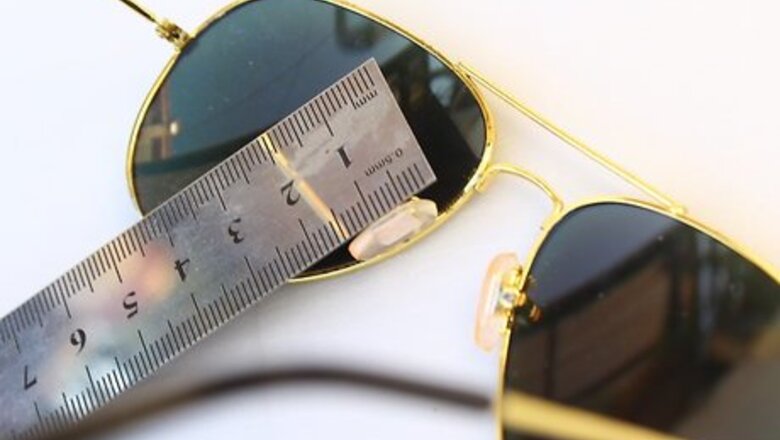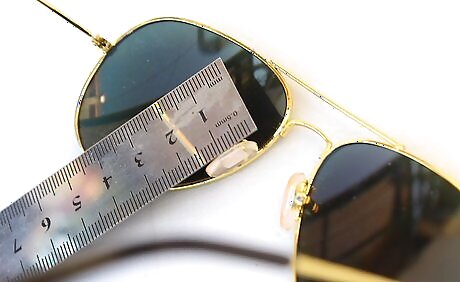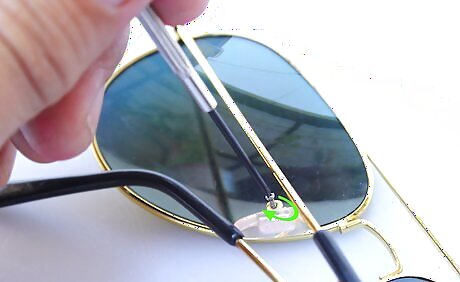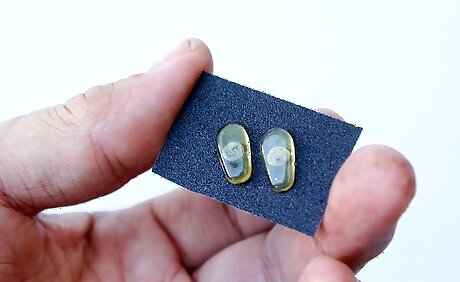
views
Changing Screw-In Style Nose Pads

Measure your old nose pads. Nose pads are typically measured in millimeters and this size refers to the length of the nose pads. Measure across the longest part of 1 pad with a ruler or tape measure marked with millimeters. For D-shaped nose pads, for example, you would measure from the top of the D to the bottom of the D rather than across the D. Nose pad sizes range from 6 to 24 millimetres (0.24 to 0.94 in).

Purchase replacements that are the same size and shape as your old nose pads. In addition to size differences, nose pads come in a variety of shapes like teardrop, rectangle, circle, or D-shaped. Look for the same size and shape online, at your local drugstore, an optical shop, or your ophthalmologist's office. Nose pads are also offered in a variety of materials including: glass, plastic, rubber, ceramic, and silicone. Consider trying silicone for comfort even if your old nose pads are made from another material. You can purchase replacement nose pads in a kit that also includes a little screwdriver, magnifying glass, cloth, and screws. If you don’t purchase a kit, you will need a jeweler’s flat head screwdriver.

Remove the old or damaged nose pad you wish to replace. Hold your glasses gently with 1 hand, nose pads facing up toward you. Locate the screw on the nose pad. Place the screwdriver gently into the groove and rotate the screwdriver to the left until the screw is loose enough to pull out. Remove the nose pad from the mount. You can reuse the screw if you’d like but check to make sure the threads aren’t stripped and the head is intact.

Place the new nose pad onto the mount. Make sure you line up the hole for the screw that is on the nose pad with the 1 on the mount. If you find this difficult, try using a pair of tweezers instead of your fingers to hold on to the nose pad. For the D-shaped nose pad, there is a right and left side difference. The flat edge of the D faces away from the face.

Insert the screw through the hole on the nose pad. Use either your fingers or a pair of tweezers to gently place the screw into the hole. Balance it there while you pick up the screwdriver.

Tighten the screw. Place the screwdriver head gently onto the groove in the screw. Exert just enough pressure to keep it in place while you turn the screwdriver to the right. Once the screw has caught, you can use more pressure to finish tightening the nose pad into place.
Switching out Snap-On Nose Pads

Measure the nose pads you want to replace. Nose pads are measured in millimeters and the size is determined by the length. Use a tape measure or ruler marked with millimeters to measure the longest part of the pad. If you have teardrop-shaped pads, for example, measure from the top of the teardrop to the bottom, rather than across the pad. Nose pads range in size from 6 to 24 millimetres (0.24 to 0.94 in) in length.

Purchase the correct size and style of replacement nose pads. Nose pads come in a variety of shapes, as well as sizes. The most common nose pads are D-shaped or oval but there are also circular, square, and teardrop shaped nose pads. Examine your old nose pads and look for the same shape online, at your local drugstore, or at an optical shop. Silicone is considered the most comfortable material for nose pads. Consider trying these even if you are replacing nose pads of a different material. Snap-on nose pads can also be referred to as push-in or click-in style nose pads.

Remove the old nose pad using a butter knife or flat head screwdriver. Cradle your glasses, nose pads up, with 1 hand. Press the thumbnail of the same hand against the mount of the nose pad you want to remove. Place the tip of the screwdriver or butter knife between your thumbnail and the nose pad and twist your tool slightly to pop the nose pad off.

Place the new nose pad onto the mount and press it into place. Line the small tab on the back of the nose pad up to the hole provided on the frames. This could be on a mount arm or right on the bridge of the frames. Press down gently and you will hear a snap when the pad is secure. If your nose pads are D-shaped, make sure the flat edge faces away from the face.




















Comments
0 comment